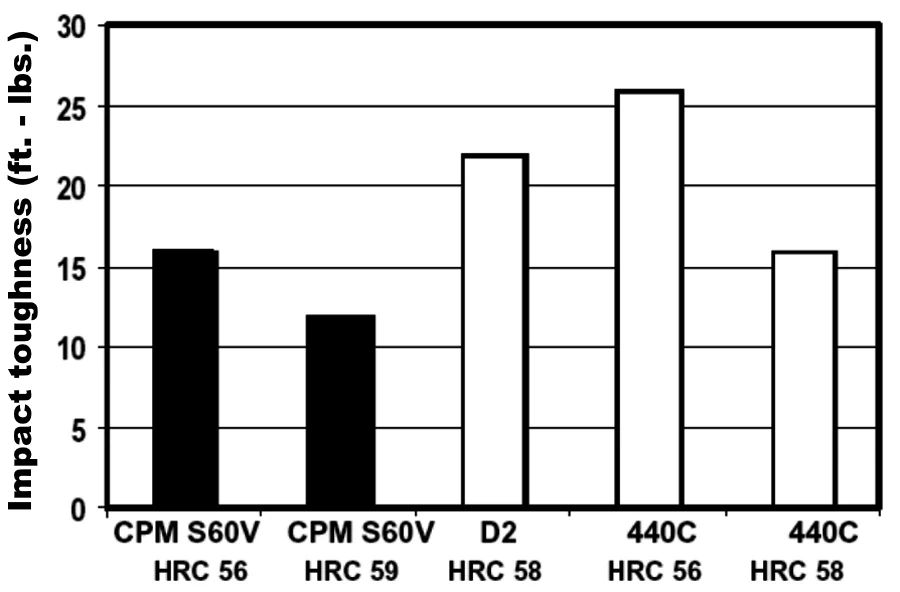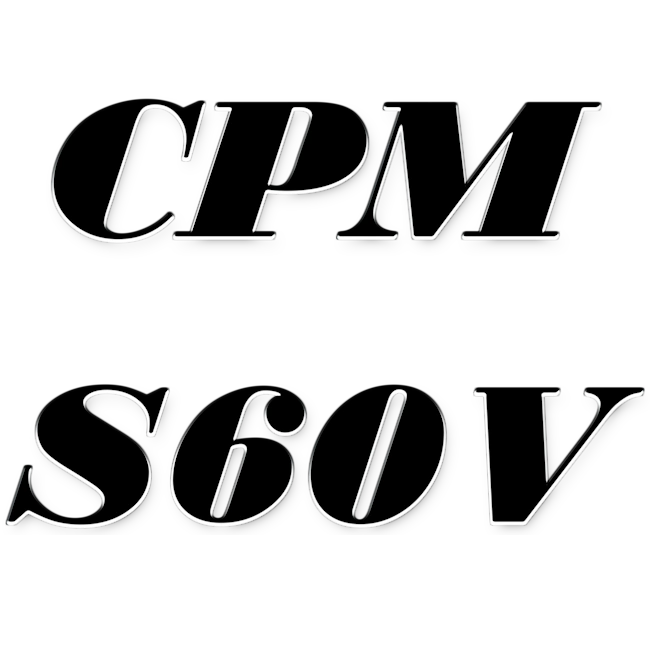CPM S60V is a corrosion-resistant, highly wear-resistant stainless tool steel manufactured by crucible metallurgy. It is essentially a 440C martensitic stainless steel enriched with a uniform dispersion of very fine vanadium carbides for exceptional wear resistance.
CPM S60V provides corrosion resistance equivalent to 440C, with significant improvements in wear resistance over 440C and D2, as well as other high chromium tool steels. With characteristics of both stainless and tool steels, S60V is ideal for corrosion-resistant applications requiring extremely high wear resistance, as well as high-wear applications requiring corrosion resistance. For the custom knife maker, CPM S60V offers a corrosion-resistant blade blank with exceptional edge retention characteristics. Only CPM S90V outperforms S60V in both wear resistance and corrosion properties, but it should be noted that S60V is easier to grind due to its lower vanadium content.
The CPM process results in a finer, more uniform distribution of carbide, which gives improved strength and grindability to high-alloy steels. The CPM process allows for the projection of higher alloy grades that are not obtainable by conventional steel production.
CPM S60V stainless powder steel made in the USA (old name - CPM 440V) was first introduced in 1995 by Crucible Industries. Some sources indicate that CPM S60V is the first stainless steel made using CPM technology. The basis for its appearance was 440C stainless steel, to which more carbon was added and vanadium was added. The hardness of the steel is 56 - 58 HRC.
Application
- Special wear-resistant cutlery;
- Industrial knives, cutters and chisels;
- Pelleting equipment;
- Wear-resistant components for food and chemical processing.
Note: These are some typical applications. Your specific application should not be undertaken without independent study and evaluation for suitability.
Wear resistance

Chemical composition
Chemical composition of steel grade CPM S60V | |||||||
| C | Cr | Mo | V | W | Mn | Si | Fe |
| 2,15 | 17,0 | 0,4 | 5,5 | 0,4 | 0,4 | 0,4 | Other |
Physical properties
- Elastic modulus: 215 hPa;
- Density: 7.4 g/cm3;
- Thermal conductivity at 93 °C: 17.3 W/m-°K;
- Coefficient of thermal expansion:
20 - 200 °C: 11.0X10-6 mm/mm/°C;
20 - 315 °C: 11.5X10-6 mm/mm/°C;
20 - 593 °C: 12.2X10-6 mm/mm/°C;
Mechanical properties
| Grade | Hardness(1) | Impact toughness(2) | ||
| HRC | Heat treatment | ft.-lb | Joules | |
| CPM S60V | 56 | (A) | 16 | (22) |
| " | 59 | (B) | 12 | (16) |
| " | 60,5 | (C) | 11 | (15) |
| 440C | 56 | (D) | 26 | (35) |
| " | 58 | (E) | 16 | (22) |
| D2 | 59 | (F) | 21 | (29) |
Toughness

(1) A = Hardened 1010 °C, double tempered 205°C;
B = Hardened 1065 °C, double tempered 205 °C;
C = Hardened 1120 °C, double tempered 205 °C;
D = Hardened 1040 °C, double tempered 315 °C;
E = Hardened 1040 °C, double tempered 205 °C;
F = Hardened 1010 °C, double tempered 315 °C;
(2) Charpe C-notch impact test;
Corrosion resistance
The corrosion resistance of CPM S60V is generally comparable to that of 440C. High temperature oxidation resistance is somewhat lower than 440C.
Special notes to knifemakers
Hardness: for bladestock, the recommended hardness is HRC 56/58, which is designed to provide an excellent combination of corrosion resistance wear resistance and edge toughness. Because of its high alloy content, CPM S60V will outperform higher hardness conventional grades of bladestock.
Heat treatment: proper heat treatment is critical to achieve optimum edge holding ability and good toughness. CPM S60V requires higher hardening temperatures than common knife grades and care must be taken to protect the blade’s surface from oxidation during heat treatment. This requires the use of a furnace with atmosphere controls, or simply wrapping the blade with stainless foil wrap. CPM S60V is air hardening, like most high alloy tool steels, but a good fast air cool is recommended to achieve proper hardness. If the blade is wrapped in foil, the foil should be removed immediately following the high heat to avoid any insulating effect. Proper tempering is also highly important. Two draws are recommended at a high enough temperature and for sufficient time to relieve stress without degrading corrosion resistance or hardness.
Recommended bladestock heat treatment:
- Austenitize: 2050 °F (1120 °C), fast air cool.
- Temper: double temper at 500 °F (260 °C) 2 hrs. each, air cooling to room temperature between tempers.
Machinability and Grindability
Due to its high vanadium carbide content, the machinability and grindability of S60V will be slightly more difficult than that of D2 or 440C. Similar grinding equipment and practices are acceptable. SG type alumina wheels or CBN wheels have generally given the best performance with the CPM steels.
Thermal treatments
- Critical temperature:: 860 °C
- Annealing: heat to 900 °C, hold 2 hours, slow cool at a maximum rate of 15 °C per hour to 595 °C, then furnace cool or cool in still air to room temperature.
Annealed hardness: approx BHN 255/277
Stress relieving
- Annealed parts: heat to 595 - 705 °C, hold for 2 hours, cool in an oven or in air.
- Hardened parts: heat to 15 - 30 °C below the original tempering temperature, hold for 2 hours, then cool in an oven or in air.
Hardening
- Austenization: 1010 - 1120 °C. Hold time at temperature: 10-30 minutes depending on section size and austenitizing temperature. Lower temperatures require longer soak times. Lower austenitizing temperatures impart greater toughness, higher austenitizing temperatures impart higher wear resistance..
- Quench: salt quench, interrupted oil quench, positive pressure gas quench or air cool at a minimum cooling rate of 80°C/min to below 540 °C. Cool to below 50 °C before tempering. For optimum vacuum heat treatment response, a minimum 4 bar gas quench is recommended.
- Temper: immediately after tools have cooled to below 50 °C. Double temper at 200 - 400 °C. Hold for aminiumum of 2 hrs. each temper. But tempering above 425 °C may result in some loss of corrosion resistance. A freezing treatment may be employed between the first and second tempers, if desired. Freezing treatments should always be followed by at least one temper..
PLEASE NOTE: tempering between about 425 and 540 °C is not recommended. All martensitic stainless steels suffer from embrittlement when tempered in this range.
Aim hardness: HRC 56/58. - Size Change: +0.02% to +0.05%. Size change shown is for a fully martensitic microstructure. The presence of retained austenite may reduce the net growth. When tempering at 400-750°F (200-400°C), freezing treatments may be necessary to minimize retained austenite.
CPM S60V: heat treat response - hardness (HRC) | ||||||
| Tempering Temperature (°C) | 1010 | 1065 | 1120 | |||
| Air | Oil | Air | Oil | Air | Oil | |
| As Quenched | 54 | 56 | 58 | 60 | 60 | 62 |
| 205 | 52 | 54 | 56 | 58 | 58 | 60 |
| 260 | 52 | 53 | 54 | 55 | 57 | 59 |
| 305 | 51 | 52 | 54 | 55 | 56 | 58 |
| 370 | 51 | 52 | 54 | 55 | 56 | 58 |
Note: properties shown throughout this data sheet are typical values. Normal variations in chemistry, size and heat treat conditions may cause deviations from these values.
